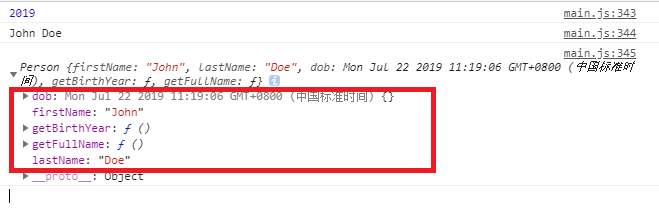Constructor functions
- Start a function name with a capitalized letter, in this case, the P in Person.
- Pass in the properties you want to be able to set,
firstName, lastName, dobhere. - Set as the properties of the object. We do that with
this. Meaningthis.dobequals the dob passed in.
// Constructor
function Person(firstName, lastName, dob) {
this.firstName = firstName;
this.lastName = lastName;
this.dob = dob;
}
// Instantiate object
const person1 = new Person('John', 'Doe', '4-3-1980');
const person2 = new Person('Marry', 'Smith', '3-6-1970');
console.log(person1)
console.log(person2.firstName);
The printout as a result of console.log(person1) is prefixed with the actual name of the object, which is Person.
Taking a side route: Date constructor
Let’s turn the date string into a date object using the date constructor.
//Constructor
function Person(firstName, lastName, dob) {
this.firstName = firstName;
this.lastName = lastName;
this.dob = new Date(dob);
}
// Instantiate object
const person1 = new Person('John', 'Doe', '4-3-1980');
const person2 = new Person('Marry', 'Smith', '3-6-1970');
console.log(person1.dob);
console.log(person2.dob.getDate());
Creating a JavaScript date instance
Creates a JavaScript Date instance that represents a single moment in time in a platform-independent format.
new Date() |
no parameters provided, so the date object represents the current date and time |
new Date(value) |
An integer value representing the number of milliseconds since January 1, 1970 00:00:00 UTC for example, new Date(1563763956000) |
new Date(datestring) |
A string value representing a date For example, new Date('4-3-1980') |
When you have a date object, there are a bunch of methods you can call on, such as getDate.
Add methods into a class
Add methods which are basically just functions to this person object.
//Constructor
function Person(firstName, lastName, dob) {
this.firstName = firstName;
this.lastName = lastName;
this.dob = new Date();
this.getBirthYear = function() {
return this.dob.getFullYear();
}
this.getFullName = function() {
return `${this.firstName} ${this.lastName}`;
}
}
//Intantiate object
const person1 = new Person('John', 'Doe', '4-3-1980');
console.log(person1.getBirthYear());
console.log(person1.getFullName());
Prototypes
Previously, we have created class using constructor functions. This, however, is not a perfect way in that properties and functions emerge side by side, like this:

So we likely wish to put the functions under prototypes (using prototype methods), like this
//Constructor
function Person(firstName, lastName, dob) {
this.firstName = firstName;
this.lastName = lastName;
this.dob = new Date();
}
Person.prototype.getBirthYear = function() {
return this.dob.getFullYear;
}
Person.prototype.getFullName = function() {
return `${this.firstName} ${this.lastName}`;
}
//Intantiate object
const person1 = new Person('John', 'Doe', '4-3-1980');
console.log(person1.getBirthYear());
console.log(person1.getFullName());
console.log(person1);
es6-powered class with methods
Do the same thing in a much prettier way, which is known as syntactic sugar.
JavaScript classes, introduced in ECMAScript 2015, are primarily syntactical sugar over JavaScript’s existing prototype-based inheritance.
What is Syntactic sugar?
In computer science, syntactic sugar is syntax within a programming language that is designed to make things easier to read or to express.
//Class
class Person {
constructor(firstName,lastName,dob) {
this.firstName = firstName;
this.lastName = lastName;
this.dob = new Date(dob);
}
getBirthYear() {
return this.dob.getFullYear;
}
getFullName() {
return `${this.firstName} ${this.lastName}`;
}
}
//Intantiate object
const person1 = new Person('John', 'Doe', '4-3-1980');
console.log(person1.getBirthYear());
console.log(person1.getFullName());
console.log(person1);